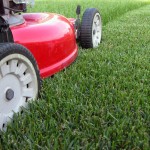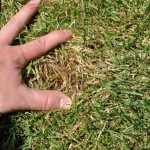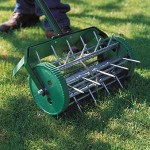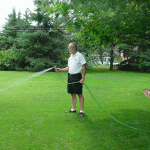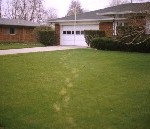The most common question at The Lawn Institute is the most difficult to answer. Asking through an email or a phone call about the health of your lawn and expecting results is about as successful as calling your doctor and asking why you are sick. Brown grass can be caused by many things. Some are harmful to the grass and some are grasses natural response to the environment that allows lawns to be successful.
Brown grass is caused by stress. Either biotic (living) or abiotic (not living) stress placed on a plant. Often both are a direct result of how we take care of our lawns. Biotic stresses include things like insect damage and disease infestation. Abiotic stress can include drought, temperature and lack of nutrients along with many other factors.
Biotic Stress
Insects- There are a tremendous amount of insects that feed on grass. Many beetles begin their lives as grubs in the soil that feed on the roots of grass. The caterpillars of some moths also live out a part of their lifecycle in lawns. For the most part insects will feed on one part of the plants, roots, crowns (the growing point at the base of the plant) or shoots (blades of grass). Root and crown feeders are usually the most devastation because shoots can readily grow back when damaged. Most insect feeding will cause rapid turf decline in irregular patches often growing larger as the insect populations increase. There are far too many insects to try and describe the damage of all in this article. The key is to try and determine if an insect is in fact killing your turf. Insect damage often makes grass look water starved or wilted because the roots are damaged and the plant can’t get water. If you suspect insect feeding is the cause for your damage we can flush them out.
Remove the bottom of a clean coffee or paint can. Push the can into the ground at the margin of a damaged site, making sure to include some undamaged turf. In a large bucket mix one quarter cup of dish soap with two gallons of water. Slowly pour this mixture onto the grass that is in your coffee can. Repeat until water will stand on top of the soil. This will cause most insects in the turf to float to the surface.
Soil burrowing insects will not surface using this technique. If grubs are causing the damage then the grass will easily roll back like carpet. Other root feeding insects can be found by parting the grass and looking at the soil surface for insect movement. There are many scavengers and beneficial insects that call your lawn home, do not assume that all insects could be the culprit. The collected insects can be taken to a local garden center or Agricultural Extension office for identification. These people can also discuss your treatment options. A healthy lawn is the best defense against lawn feeding insects.
Diseases- Lawns are attacked by a few bacterial diseases and many fungal diseases. Fungus easily breeds in some turfgrass environments. Fungal diseases are often an indication of another problem. Just as it is more difficult for a healthy person to come down with an illness it is difficult for a healthy lawn to come down with an illness as well. A lawn that has balanced fertility, good soil health and adequate moisture is less prone to disease. Different diseases affect types of grasses in different geographical regions. It is difficult to make generalizations about these diseases but for the most part fungicides are not needed to cure the problems. Diseases will occur when environmental conditions are correct for their development. Some fungal diseases can develop even when below freezing air temperatures are present. Taking a soil test and fertilizing according to its recommendations is a great way to decrease the likelihood of lawn diseases. Often times too much fertilizer is more of a problem than too little so always follow your soil test and local recommendations for fertilizer applications.
Removing surface water by better contouring of the surface, increasing soil drying by aeration to increase downward water movement and decreasing leaf wetness by irrigating in the morning are all ways to decrease disease occurrence.
Other- Animal waste elimination is a large cause of brown spots. Dog urine has long been known to kill grass. Also large birds like heron and cranes can cause burning of the turf. The damage is caused by the high levels of nutrients and salts in the waste and can only be combated by immediately applying water to the affected area to dilute the concentrations.
Abiotic Stress
Grasses require a certain set of conditions to grow correctly. Brown spots are most often caused by abiotic stress. High or low temperatures can cause grasses to brown as can drought conditions. Often the browning is caused by protective plant dormancy. When conditions become favorable for growth again then the grass will begin growing green shoots once again.
Nutrient deficiencies or imbalances and high or low soil pH levels can cause grass to brown. Different plants grow best under differing conditions. A soil test is usually needed for diagnosis of these problems.
Excess fertility caused by spills or overlaps can often cause brown spots in lawns. Every year homeowners over apply fertilizer and cause grass to brown. To reduce these problems always fill your fertilizer bag over a hard surface and follow the fertilizer manufacturers recommendations for application.
Things you would never think of can also cause brown spots in grass. Bug spray is a huge culprit. Often found are two green footprints with brown grass surrounding them. The bug spray could not get under the shoes of the applicator but the bug spray affected all of the surrounding exposed grass.
Differing conditions under the grass can cause brown spots as well. Pockets of stone or sand can cause the grass above to dry out rapidly. As well clay below ground can decrease the grasses ability to root once again causing brown spots. Some times the brownspots are even caused by having different species of grass in the same lawn.
Mowing is a repeated stress on grass and if not done correctly can easily cause brown spots or even a brown tint to the entire lawn. When grass is cut to short it will often expose more dead grass and expose more of the soil. Not only does this cause an unsightly appearance it is also not good for plant health. Dull mowing equipment can also cause the grass to appear brown because it tears grass and leaves rough edges that dry out.
The reasons for brown spots in lawns are numerous. Diagnoses of lawn problems beyond the rudimentary almost always need a trained professional or a seasoned veteran. Universities offer advanced and specialized degrees on the subject and thousands of books have been written. Determining why that brown spot is in your lawn is not as easy as you might think so do not be discouraged if you get differing opinions.
